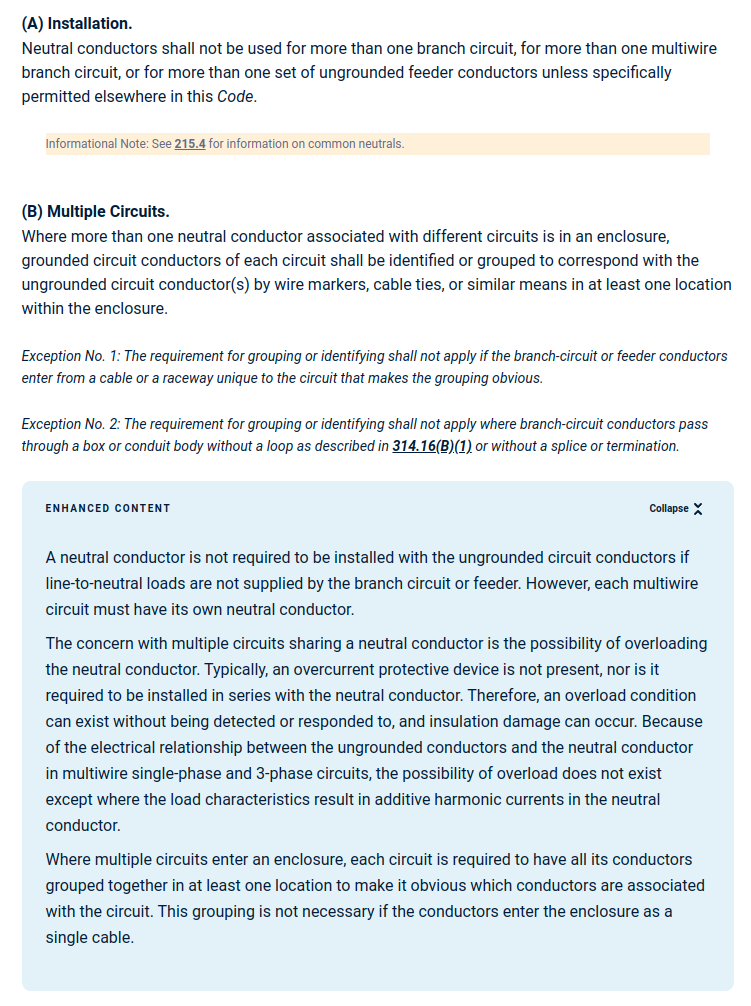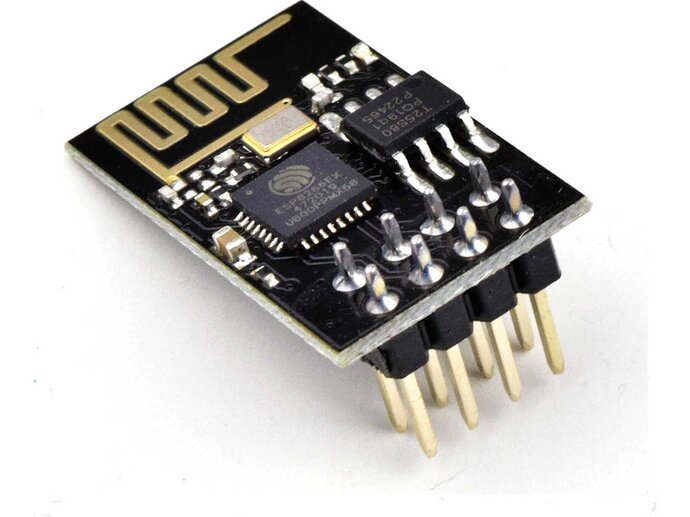I 100% agree. Really what I meant was that when I’ve got the fan supported by a hook if I have one, or my ladder if I don’t, it’s farther away from the supply wires than I’d normally want my wire length to be.
I’m not sure what you mean by “need to be tied together.” They’re presumably tied together inside the canopy module, so I don’t see why you’d need to also connect them on the outside.
All neutral conductors on the same branch circuit must be bundled together inside of the box. That means twisted together with a wire nut or connected together with a Wago.
I’ve never seen that requirement before, and it doesn’t sound like the kind of thing the NEC would require. Do you have a code citation?
It’s 200 something. Find the one that speaks about neutrals and separating them when they are on different branch circuits. It’s implicit in that one and it may be specifically stated somewhere else.
Wouldn’t that be covered by the connection between the neutrals in the canopy module? Just like how you can have two wire nuts of neutrals on the same branch circuit in the same wall box as long as there is a wire connecting them.
So this is a bit of an academic argument but here is my thinking…
If the two neutrals inside the canopy are connected then the answer would be yes. But I don’t know that they are and they may not have to be. The canopy isn’t really a thing yet so who knows.
But let’s look at the practical side of this. Any electrician worth his salt would look into that box with separately tied neutrals and then look at you like you don’t know what you’re doing. Because, probably, there is a pretty good shot that you don’t. It’s just not done that way.
And for arguments sake, let’s say an inspector is looking at that box. He or she has no way of knowing whether those two conductors going into the canopy or tied together or not. So while you may be technically correct, you may very well find a red tag on your load center.
The NEC is sometimes not as specific as perhaps it should be. And sometimes inspectors want something that you can’t quite agree with or find specifically in the code. So you have to factor in the “that’s how it’s done around here” factor.
I bundle my neutrals. Just sayin’ … ![]()
I think they’d have to be, otherwise the fan (or the lights) wouldn’t get a neutral if it was connected if the load side neutral wasn’t connected to the line side neutral.
But I agree with you, which is why my original suggestion was to just have a single neutral wire on the canopy.
I guess I’m considering it to be the same as the two positions on the backplate of the Red/Blue 2-1’s where you can connect the neutral wires. Maybe it’s more obvious they are connected because it’s a switch.
I think I found what you’re referring to, but it doesn’t say what I think you’re saying it says.
NEC 2023, Article 200.4: Neutral Conductors
That Exception 1 pretty clearly says that none of this applies if there is no possible way to be confused about which neutral is on which circuit.
On a practical level, the neutral wire (Grounded conductor in NEC parlance) is a critical part of the circuit. If it’s not hooked up, the current won’t flow. So the answer to “how do I know these neutrals are connected inside” is that if they weren’t, then the fan/light wouldn’t turn on.
As far as this goes:
The NEC is not implicit.

I just thought of an idea that’s probably too late for this fan canopy module iteration, but would provide flexibility and possibly decreased SKU counts in the future. Make the main canopy PCB contain all of the fan speed and dimmer electronics, but no controller electronics. Instead, include DIP headers or a socket on the canopy’s PCB to receive a Zigbee, Z-Wave, wifi, Bluetooth, or whatever plug-in controller module.
I don’t know how this will impact UL and Z-Wave certifications, but I could see it saving shelf space for offering different protocol variants if the choice of controller module could be installed at Inovelli HQ or even better by the end user.
For illustration, I’m thinking of various plug-in controller modules similar to this:
Will this work with a two switch setup?
All of my rooms have two switches for the ceiling fans. I would think I could wire up the Fan Switch as the load and use a 2-1 switch next to it disconnected to control the light by binding. Is this achievable as it is now?
If not I would l want to request it be a feature for having the ability to run as a two switch setup with a detonated switch for each the fan and light.
If you have two switches already today, you don’t need the canopy module. You can just wire the 2-1 directly to the lights and the blue fan switch directly to the fan. This is needed in the situation where there is only a single switch (or no switch) controlling both together.
I guess you may be right. Never thought about it thought way since my fan came with a module for its built in RF remote. I ended up using a sonoff wifi module a Shelly 2.5 for each switch. I leave the line hot to the module and use the Shelly to send commands for the WiFi controls based on switch changes.
I will have to see if I can bypass the control module all together.
After looking into it, non of my fans have a pull chain. Would that still be an option to bypass the control module and have the ability to control the fan speed?
2 fans have an on/off light with 3 speeds and AC
1 fan has a dimming light with 3 speeds and AC
1 fan has a ambient light settings with 6 speeds and DC
Looking into the fan controller looks like I will not get the 6 speed control or the ambient light changes which is all fine, but I still think there is a use case to have a module that can wire up to two switches correct? I understand that this may not have all the features to fit all my fans but I don’t think I could get by without a module at all.
I want this do bad. I literally have pre ordered 2 extra fan switches. I didn’t want to have to worry about wiring the fans. Currently there is just a plate cover on our ceilings where fans used to be.
This is so amazing.
If I missed it in the thread that’s OK, any thought of adding mmWave to the module? Seems prefect idea to me. Especially if we are requiring neutral might be some room there…
You really have to look at the fan’s specs to determine if the motor is AC or DC. Some of those other things like a pull chain or remote are hints, but not conclusive. For example, some fans with a remote have AC motor, but others have a DC motor.
You initially had me going, “dang, that would be a perfect idea since it’s in the center of the room!”
Then I thought, “dang again… the fan blades would really screw up the sensor readings lol”.
However, I’ve been secretly stewing an idea that I’m about ready to announce that’s similar to what you’re thinking… think of something below the fan blades we could put the sensor in ![]()
Just so you’re aware, you’ll control the canopy via binding, so the Blue 2-1 will also work with it.
What is the difference between this canopy module and the Fan Switch? To me they work the same if used for ceiling fans. I think could bypass the existing controls and be set with the fan switch directly connected with 3 speed controls since most of my fans are AC.
From what I can tell the fan switch should have all the protections and capacitors needed to run a 3 speed fan. The problem I have is if you have a pull chain fan you have to set it at full speed to use a wall switch control. If I have no chain, is bypassing the control effectively a full speed connection but the needed relays/capacitors are in the wall switch?
I may be out of luck on my DC fan but noticed that it was in the specs for this module. I think this would be the solution for me if I could still use two switches and am willing to give up 6 speed/ambient lighting for just 3 speed and on/off light.
If you are thinking light…
Would it be something like this?
Hisoo 2 Pack LED Light Engine Retrofit Kit, 6inch 24W 2200Lm, 3CCT 3000K/4000K/5000K Dimmable, Ceiling Fan Light Kits, LED Light Engine for Ceiling Light, Ceiling Fan Light, Pendant, Lantern https://a.co/d/ctgLRr2
If you are able to build something like this with mmWave and while having the ability to adjust color temperature/dim sign me up!!

